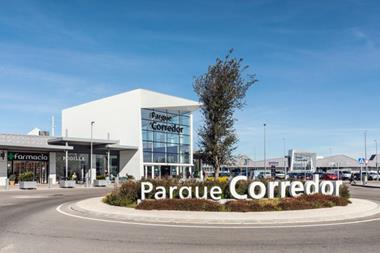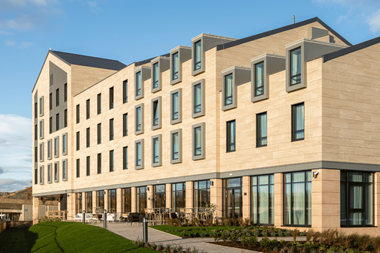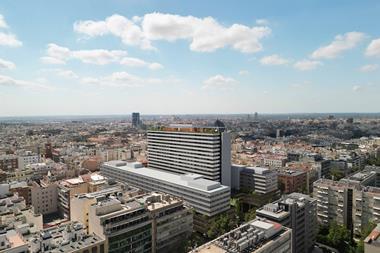Spain and Italy both recorded real estate investment volumes close to €2 bn in the first quarter of 2015, and appeared to match each other with big-ticket deals in the following weeks even though there is a marked contrast in fundamentals between the two markets.
Spain and Italy both recorded real estate investment volumes close to €2 bn in the first quarter of 2015, and appeared to match each other with big-ticket deals in the following weeks even though there is a marked contrast in fundamentals between the two markets.
The latest big deal occurred in Spain on 24 April as AXA Real Estate completed the acquisition of 381 Santander bank branches for €308 mln.
The 381 assets located throughout Spain total 90,000 m2 and are fully let on 24-26 year leases to Santander, the largest banking company within the country.
On 13 April another the Spanish market received another important, albeit smaller scale, vote of confidence when the Student Hotel, a student housing platform primarily focused on the Benelux region, made its first foray into the southern European market.
The Student Hotel acquired two student halls operated by Melon District in Barcelona from a unit of lender BBVA for an undisclosed amount. The move into Spain is part of The Student Hotel expansion into key European markets.
Not to be outdone Italy also saw big infusions of foreign capital into its real estate market in April. In the middle of the month Chinese conglomerate Fosun emerged as the surprise winner against more usual suspects Hines and Abu Dhabi Investment Authority to acquire the one of Milan's historic jewels, Unicredit's former headquarters, for €345 mln.
CBRE handled the sales process for the largest trophy asset to change hands in Italy in years. The transaction is also believed to represent Fosun's first foray into the European property market.
Around the same time Cerberus carried out Italy's largest real estate portfolio acquisition in two years. The US private equity firm acquired two army barracks in Bari and Rome used by the Guardia di Finanza as well as three other assets across the country for €230 mln. Also in mid-April Tristan Capital Partners marked its entry into Italy by purchasing four retail assets for €120 mln.
Q1
Looking at just the largest deals Italy may have edged ahead of its southern neighbour in April, but based on the evidence from Q1, both in terms of transaction data and market fundamentals, Spain is set to challenge Italy for the title of the most active southern investment location in the months ahead.
PropertyEU Research analysed deals for which the investment volumes were reported or could be discovered between January and end-March 2015. The data indicates a preliminary volume of €1.8 bn for the Spanish market and over €1.9 for Italy. The recovering Portuguese market is attracting investor attention but has yet to see big-volume transactions.
Although Spain and Italy were virtually tied in terms of volumes for the reported deals, the two markets saw unique investment patterns as the markets recover at differing speeds.
Looking up
The first point of contrast relates to the type of investors active in both markets. Italy is still seeing a predominance of US private equity houses and opportunistic funds such as Blackstone, Cerberus, Kennedy Wilson, Tristan.
Spain appears to be further ahead in the property cycle with more institutional-type of equity, such as AXA REIM and Klépierre or players looking for value in the regions, such as CBREGI in Seville, or Spanish investor Lar active in Lugo.
Economically Spain’s economic output is rebounding from a very deep trough. GDP growth of 0.8% GDP growth in the last quarter of 2014 rose to 2.5% in Q1 and appears set to hit 2.8% for the full year. There is also good news on the problematic unemployment front: about a quarter of the work population were jobless in 2014, but there was a record fall of 250,000 during the year. This was the highest percentage fall of any eurozone country.
Italy, in contrast, recently ungraded its 2015 GDP forecast from 0.6% to 0.7%. The country’s unemployment rate came down from 13.2% in late-2014 to hover around 12.6-12.7% during the first three months of this year.
IPD
The commercial real estate market in Spain is giving off ‘further signs of a recovery’, according to MSCI. The IPD Spain Annual Property Index showed a 10.1% total return in 2014, a rise from 0.3% in 2013, and the first time the index has reached double figures since 2007’s figure of 12.4%, just before the country’s prolonged property crash and recession.
Elsa Galindo, Senior Associate, MSCI commented: ‘After many years of negative and sometimes cataclysmic return levels, favourable trends in macroeconomic fundamentals seem to have had a positive impact on confidence levels within the real estate sector. Capital values have increased, driven by the recovery in fundamentals and by the high liquidity existing in the market. Investors will hope that the 2014 Index results will mark an important part of the economic cycle as we see a gradual recovery both in the real estate market and in the Spanish economy as a whole.’
Overall, Spanish commercial property outperformed the domestic equity market, which returned 8.9% (Spain MSCI Index), but underperformed bonds, which delivered 24.5% (JP Morgan) in 2014.
The situation in Italy, as measured by the IPD Italy Biannual Property Fund Index to December 2014, is less rosy.
Bucking the trend of the general European economic recovery, Italian real estate funds are still underperforming based on 2014 data. Despite the IPD Italy Biannual Property Fund Index recording total returns of 0.6% on an six-monthly basis, it still performing in negative territory (-1.9%) on an annual basis. A comparison with Equities (3.6% MSCI) and Bonds (19.6% JP Morgan GBI Italy Index) also shows Italian property funds underperforming,
Deal flow
PropertyEU Research tracked 15 transactions of €20 mln or above in Spain during the review period. The largest transaction took place in late January when Amancio Ortega, founder of Spain-based retail clothing group Inditex, operating through his investment company Pontegadea, acquired a 36,400 m2 office and retail property on the Gran Via prime high-street in Madrid. The investment volume came to €400 mln. The deal gives Ortega control of the base of a 9,000 m2 megastore operated by Primark, its first in the Spanish market.
An additional international element to the deal stems from the vendor joint venture represented by Madrid-based Drago Capital. Drago bought a half share in the asset from major Spanish media group Prisa in 2008 on behalf of a consortium including Dutch pension fund APG, UK insurer Phoenix Group and UK investor Sun Capital. The asset was acquired together with the office at Miguel Yuste 40 and the headquarters of Cadena Ser in Calle Caspe, Barcelona for a total of €315 mln. A year later Drago acquired the remaining 50% interest in partnership with Canada's PSP Investments.
Cushman & Wakefield and law firm Gómez-Acebo & Pombo advised Drago on the sale to Pontegadea. Commenting on an upturn in investment in the Spanish capital, Adolfo Ramirez-Escudero, head of Spain at CBRE, said, 'The sale of Gran Vía 32, together with other significant deals such as Castellana 77, the BMW building and Gran Vía 14 are a clear example of the strength of the market. We believe 2015 will set a record year in terms of investment volume.'
Madrid's retail property sector was again in the spotlight in March when Listed European shopping centre landlord Klépierre acquired control of the 70,000 m2 Plenilunio shopping centre, located in the northeast of the city, from Orion Capital Managers' European Real Estate Fund III. The transaction price comes to €375 mln, or a yield of less than 5%.
There was also life outside the capital in Q1. US-based private equity firm Starwood Capital Group launched a joint venture with operator Melia Hotels International in March to acquire a portfolio of seven hotels for €176 mln. The beachfront hotels are located in Malaga, the Canary Islands, Ibiza and Mallorca.
And in Seville CBRE Global Investors completed the acquisition of Airesur, the largest shopping centre in the southern Spanish city of Seville, for €76.5 mln.
Milan
Italian real estate has always been more insular than its neighbouring markets, so it is interesting to observe that the key investments in Q1 were all carried out by cross-border buyers.
On the other hand, the preponderance of activity centred on Milan, which is more of a global hub and industrial powerhouse than an ordinary Italian metropolis. The largest transaction of the period by far saw Qatar Investment Authority taking full control of Milan's Porta Nuova mixed-use scheme for an estimated €1.2 bn.
Other notable deals included Swiss-headquartered Partners Group picked up two prime offices in Milan for €230 mln, and US private equity firm Cerberus extending its Italian holdings by acquiring seven former army barracks in Beri, Rome, Bergamo for €250 mln.










